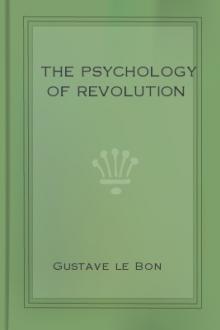The Psychology of Beauty by Ethel D. Puffer (good non fiction books to read TXT) 📕

- Author: Ethel D. Puffer
- Performer: -
Book online «The Psychology of Beauty by Ethel D. Puffer (good non fiction books to read TXT) 📕». Author Ethel D. Puffer
The experience is, on the contrary, immediate,—an impression, not a perception; and this immediacy points to the one ultimate fact in musical feeling we have so far discovered. The whole development of the scale, and the complex feeling of tonality, is an expression of the desire for consonance. Every change and correction in the scale has gone to make every note more consonant with its neighbors. And naturally the tonic is the tone with which all other tones have the most unity. Now this “return” phenomenon is a simpler case of the desire for the feeling of unity. The tonic is the epitome of all the most perfect feelings of consonance or unity which are possible in any particular sequence of tones, and is therefore the goal or resting-place after an excursion. The undoubted feeling of equilibrium or repose which we have in ending on the tonic is thus explained. Not that consonance itself, the feeling of unity, is explained. But at any rate consonance is the root of the “return,” and of its development into complete tonality.
The history of music is then the explicit development of acoustic laws implicit in every stage of musical feeling. That feeling covers an ever wider field. When Mr. Hadow says that the terms concord and discord are wholly relative to the ear of the listener,<1> and that the distinction between them is not to be explained on any mathematical basis, or by any a priori law of acoustics,—that it is not because a minor second is ugly that we dislike it, for it will be a concord some day,—he is only partly right. The minor second may be a “concord,” that is, we may like it, some day; but that will be because w have extended our feeling of tonality to include the minor second. When that day comes the minor second will be so closely linked with other fully consonant combinations that we shall hear it in terms of them, just as to-day we hear the chord of the dominant seventh in terms of its resolution. But the basis will not be convention or custom, except in so far as custom is the unfolding of natural law.
The course of music, like that of every other art, is away from arbitrary—though simple—convention, to a complexity which satisfies the natural demands of the organism. The “natural persuasion” of the ear is omnipotent.
<1> W.H. Hadow, Studies in Modern Music, 1893.
VIt has been said that the feeling of tonality is a motor image or “form-quality” and that the image of the tonic persists throughout every sequence of tones in a melody. Now these are not only felt as having a certain relation to the tonic; that relation is an active one. It was said that we had a positive desire to end on a certain tone, and that a tendency to pass to that tone was bound up with the hearing of another tone.
The degree of this tendency is determined by their relation.
The key, the tonality, is determined by the consensus of intervals which have been felt as more or less consonant.
Then steps in this scale which come near to the great salient points—that is, the points of greatest consonance, which is unity, which is rest—are felt as suggesting them. This is the reason why a semitone progression is felt as so compelling.
In taking the scale upward, C to C’, that element in the tone-Space already clearly foreshadowed by the previous tones is C’; B is so near that it is almost C’—it seems to cry aloud to be completed by C’. Then the tendency to move from B to C’ is especially strong. In the same way a chromatic note suggests most strongly the salient point in the scheme to which it is nearest—and “tends” to it as to a point of comparative rest.
The difference between the major and minor scales may be found in the lesser definiteness<1> with which the tendency to progression, in the latter, is felt—“a condition of hovering, a kind of ambiguity, of doubt, to which side the movement shall proceed.” We may then understand a melody as ever tending with various degrees of urgency, of strain, to its centre of gravity, the tonic.
<1> F. Weinmann, Zeitschr. f. Psychol., Bd. 35, p. 360.
It is from this point of view that we can see the cogency of Gurney’s remark, that when music seems to be yearning for unutterable things, it is really yearning only for the next note. “In this step from the state of rest into movement and return, the coming again to rest; on what circuitous ways, with what reluctances and hesitations; whether quick and decisively or gradually and unnoticed—therein consists the nature of melody.”<1>
<1> Weinmann, op. cit.
Or in Gurney’s more eloquent description, “The melody may begin by pressing its way through a sweetly yielding resistance to a gradually foreseen climax; whence again fresh expectation is bred, perhaps for another excursion, as it were, round the same centre but with a bolder and freer sweep,…to a point where again the motive is suspended on another temporary goal; till after a certain number of such involutions and evolutions, and of delicately poised leanings and reluctances and yieldings, the forces so accurately measured just suffice to bring it home, and the sense of potential and coming integration which has underlain all our provisional adjustments of expectation is triumphantly justified.”<1>
<1> Op. cit., p. 165.
This should not be taken as a more or less poetical account under the metaphor of motion. These “leanings” are literal in the sense that one note does imply another as its natural complement and satisfaction and we seek to reach or make it.
The striving is an intrinsic element, not a by-product for our understanding.
There is another point to note. The “sense of potential and coming integration” is a strong factor of melody. If it cannot be said that the first note implies the last, it is at least true that from point to point the next step is dimly foreseen, and this effect is cumulative. If melody is an ever-hindered striving for the goal, at least the hindrances themselves are stations on the way, each one as overcome adding to the final momentum with which the goal is reached. It is like an accumulation of evidence, a constellation of associations. AB
foretells C; but ABCDEF rushes yet more strongly upon G. So it is that the irresistibleness, the “unalterable rightness”
of a piece of music increases from beginning to end.
The significance of this essential internal necessity of progression cannot be overestimated. The unalterable rightness of music is founded on natural acoustic laws, and this “rightness” is fundamental. A melody is not right because it is beautiful, it is beautiful because it is right. The natural tendencies point out different paths to the goal; and thus different ways of being beautiful; but the nature of the relation between point and point, the nature of the progression, that is, the nature of melody, is the same.
Up to this point we have consistently abstracted from the element of rhythm in melody. Strictly speaking, however, it is impossible to do so. The individuality of a melody is absolutely dependent on its rhythm, that is, on the relative time-value of its tones. Gurney has devoted some amusing pages to showing the trivial, dragging, lustreless tunes that result from ever so slight a change in the rhythm of noble themes, or even in the distribution of rhythmical elements within the bar.
The reason for this is evident. The nature of melody in the sense of sequence consists in the varied answers to the demands of the ear as felt at each successive point. Now it is clear that such “answer” can be emphasized, given indifferently, held in suspense, in short, subjected to all kinds of variation as well by the rhythmical form into which it is cast, as by the different choice of possibilities for the tone itself. The rhythm helps out the melody not only by adding to it an independently pleasing element, but, and this is indeed the essential, by reinforcing the intrinsic relations of the notes themselves. Thus it is in the highest degree true that in melody and rhythm we do not have content and form, but that, strictly speaking, the melody is tone-sequence in rhythm.
The intimate bondage of tone-sequence and rhythm is grounded in the identity of their inner nature; both are varieties of the objective conditions of embodied expectation. It is not of the essence of music to satisfy explicit and conscious expectation—to satisfy the understanding. It meets on the contrary a subconscious, automatic need which becomes conscious only in the moment of its contenting. Every moment of progress in a beautiful melody is hailed like an instinctive action performed for the first time. Rhythm is the ideal satisfaction of attention in general with all its bodily concomitants and expressions. Tone-sequence is the satisfaction of attention directed to auditory demands. But the form-quality of rhythm, the form-quality of tonality, is an all but subconscious possession. Together, reinforcing each other in melody, they furnish the ideal arrangement of the most poignant of sense-stimulations.
VIIt is strange that those who would accept the general facts of musical logic as outlined above do not perceive that they have thereby cut away the ground from under the feet of the “natural language” argument. If the principle of choice in the progress of a melody is tone-relationship, the principle of choice cannot also be the cadences of the speaking voice. That musical intervals often RECALL the speaking voice is another matter, as we have said, and to this it may be added that they much more often do not. The question here is only of the primacy of the principle. Thus it would seem that the facts of musical structure constitute in themselves a refutation of the view we have disputed.
To say that music arose in “heightened speech” is irrelevant; for the occasion of an aesthetic phenomenon is never its cause. It might as well be said that music arose in economic conditions,—
as indeed Grosse, in his “Anfange der Kunst,” conclusively shows, without attempting to make this social occasion intrude into the nature of the phenomenon. Primitive decorative art arose in the imitation of the totemic or clan symbols, mostly animal forms; but we have seen that the aesthetic quality of the decoration is due to the demands of the eye, and appears fully only in the comparative degradation of the representative form. In exactly the same way might we consider the “degradation” of speech cadences into real music,—supposing this were really the origin of music. As a matter of fact, however, the best authorities seem to be agreed that the primitive “dance-song” was rather a monotonous, meaningless chant, and that the original pitch-elements were mechanically supplied by the first musical instruments; these being at first merely for noise, and becoming truly vibrating, sonorous bodies because they were more easily struck if they were hard or taut. The musical tones which these hard vibrating bodies gave out were the first determinations of pitch, and of the elements of the scale, which correspond to the natural partial vibrations of such bodies. “The human voice,”
Wallaschek<1> tells us, “equally admits of any pentatonic or heptatonic intervals, and very likely we





Comments (0)